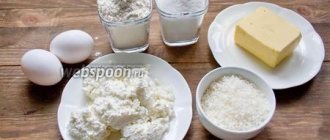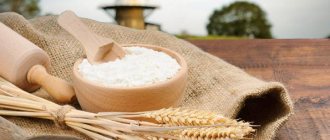How and from what is coconut flour made?
Flour is one of the minor products obtained from the production of coconut oil. The fat is squeezed out of the fruit, leaving a cake with a small oil content, which is the basis for making flour. The process of its creation is divided into four main steps:
- dehydration of coconut flesh when heated;
- grinding wet pulp;
- drying;
- grinding the pulp into flour in a food processor or blender.
As a result of processing, a white powdery consistency with unique properties is obtained. Its taste and smell remain the same as that of coconut.
How to use Coconut Flour?
I want to warn you right away - you won’t be able to simply replace wheat or any other flour with coconut flour. Coconut Flour is unique. Therefore, I recommend either experimenting with the amount of ingredients yourself or looking for recipes specifically designed for Coconut Flour.
It absorbs liquid and swells very easily. Also, since it does not contain Gluten, it needs eggs for stickiness. That is, if for regular pancakes you need 1-2 eggs, in recipes with Coconut Flour you will need 3-4.
Coconut Flour needs to be mixed well in recipes as it has a tendency to form lumps. Also, I advise you to let it sit for a few minutes after kneading the dough.
Coconut is not very popular among us, perhaps because it is not easy to break through its thick and very hard shell; you need tools, strength and skill. But if you try its dense pulp with a unique aroma and taste at least once, you will no longer be able to resist the desire to enjoy it again and again.
By the way, the coconut is called a nut by mistake; in fact, the fruit of the palm tree is a drupe, like the well-known cherries, plums and sweet cherries. Pulp, milk, coconut sugar and oil have unique nutritional and healing properties,
they are actively used not only in cooking, but also as a cure for dozens of diseases. This amazing fruit is able to provide a person with all the necessary microelements. We will tell you about this in this material.
Nutritional value and calorie content of coconut flour
100 grams of natural substance contain 19 grams of protein, 12 grams of fat and 9 grams of carbohydrates. The energy value of this food product is 320 kilocalories. The glycemic index of coconut flour is 45, which is 30 units less than that of wheat or corn flour, which is certainly beneficial for the diet of diabetics.
Important! It is generally accepted that the composition and properties of coconut pulp and flour are the same. In fact, they contain the same substances, but in different consistencies.
Coconut flour: chemical composition
It is incorrect to assume that the chemical composition of coconut flour is similar to that of shavings. In terms of vitamin and mineral diversity, these products are very similar, but the proportions of the main nutrients are very different. In chips, the mass fraction of fat is 30-70%, and in flour - a maximum of 25%. But both products contain vitamins B1-B9, C, E, as well as calcium, potassium, iron, phosphorus, sodium and some essential fatty acids.
Coconut flour benefits and harm to the body
Nutritional value and calorie content
It is low in calories and low in carbohydrates. The following nutritional value indicators for 100 grams of coconut flour are considered reference:
- calorie content: 440 kcal;
- proteins: 20 g;
- fat: 14 g;
- carbohydrates: 60 g.
However, some manufacturers indicate different figures, justifying this with a reduced fat content, which gives a large increase in calorie content. For example, coconut flour from Florina has the following indicators:
- calorie content: 320 kcal;
- proteins: 19 g;
- carbohydrates: 9 g.
Benefits of Coconut Flour
- Large (for flour) amount of protein in the complete absence of gluten. This product is useful and available for diabetes, celiac disease, and excess weight. An excellent source of complete vegetable protein (100 grams contain 19 grams). For comparison, wheat flour contains only 10 grams of protein per 100 grams of flour.
- The high fiber content, which improves digestion, “inhibits” the absorption of carbohydrates (blood glucose levels do not “jump”) and stimulates the absorption of minerals and vitamins.
- It has a low glycemic index, so it can be safely consumed by those with high blood sugar. This property of coconut flour was confirmed by medical scientists back in 2003. The glycemic index is almost half that of wheat flour.
- Many fats are in the form of medium-chain triglycerides. This means that they help reduce appetite and burn stored fat.
- A characteristic pleasant aroma that “classic” flours like rye or wheat do not have.
- Compared to most flours, coconut flour has a more balanced ratio of fatty acids in its chemical composition, which is important for a complete supply of the body.
- Like coconut oil, it does not contain phytic acid, a compound that interferes with the absorption of nutrients.
Product Disadvantages
- This product is not cheap at all, I must say.
- If you have a weak digestive system, then do not consume a lot of coconut flour. The high content of dietary fiber in the composition can cause discomfort in your stomach, since your digestive system will not be able to cope with such an influx of fiber!
- If you are allergic to any component of coconut flour, in other words, you have an individual intolerance, then do not use this flour!
Benefits of coconut flour
If you compare it with any other similar product, then it is more useful. And the benefits lie in the following properties:
- It contains manganese. Its benefits for the body have been proven. It helps improve the functioning of the musculoskeletal system and nervous system, and also helps regulate blood sugar levels.
- Another useful element in the composition is lauric acid. It also brings great benefits to the body - strengthens the immune system and normalizes the functioning of the thyroid gland.
- High protein content, which brings exceptional benefits to the human body. But there is very little fat in it that causes harm.
We recommend reading: What propolis helps with, beneficial properties and contraindications, how to take it
Coconut flour does not contain harmful components such as gluten, digestive enzyme inhibitors and excessive amounts of Omega-6. Therefore, it is allowed to be consumed even by people suffering from diabetes. In addition, it is economical, since its consumption is 2-3 times lower than regular flour.
Summarize
- Coconut flour is a gluten-free flour made exclusively from coconuts.
- Rich in fiber and MCTs, it can support stable blood sugar levels, good digestion and heart health. It may also promote weight loss and fight certain infections.
- Plus, it's delicious and versatile, making it a smart choice when choosing flour.
Tags: Coconut, Flour
- Related Posts
- What are the benefits of coconut for the human body?
- Can people eat oak acorns?
- Can you eat coffee beans? Benefits and harms
« Previous entry
Medicinal properties of coconut flour
It has a number of useful properties. It is also widely used in medicine for the preparation of medicines or folk remedies. Regular consumption will allow a person to get rid of a number of diseases:
- Saturation with fatty acids, which ensure dilution and removal of bile from the body. The substances included in its composition increase the tone of the walls of blood vessels. Therefore, healthy flour is recommended for people who have diseases associated with the gastrointestinal tract.
- Its properties are also useful for people with arrhythmia and arterial hypertension. Active components help regulate blood pressure and improve brain function.
- High amounts of protein benefit male reproductive function.
Having studied all the properties, we can say that coconut flour is a healthy and safe product. But still, you should not self-medicate. If it is used for medical purposes, you should consult a doctor before use. Otherwise it may cause harm.
The use of coconut flour in cosmetology
Valuable flour is included in many expensive products for the skin of the face and body. Its beneficial properties:
- Hydration. Moreover, the positive effect occurs after the first use.
- Provides saturation with useful substances.
- It benefits older women, as it has excellent anti-aging properties - smoothes out wrinkles and makes the skin elastic.
- Another useful property is the acceleration of the wound healing process.
Comment! There is absolutely no need to spend money on expensive cosmetics. You can also make a face mask at home. The risk of harm from such a cosmetic product is almost zero.
Recipe No. 1
- The main component should be combined with heated liquid honey in equal proportions.
- Mix the ingredients thoroughly until a homogeneous consistency is obtained.
The property of such a mask is to create moisturizing and nourishing effects.
Recipe No. 2
To create a rejuvenating effect, it is recommended to regularly make a mask of coconut flour and olive oil.
The preparation method is simple:
- Mix 2 components in equal quantities.
- Apply to the face and décolleté, rinse after 20 minutes.
It is recommended to repeat the procedure 2-3 times a week for a month. Obvious benefits will be noticeable after the first use.
How to make coconut flour at home
Flour in its natural form can rarely be found in the store. But making coconut flour at home is easy and requires just a few basic steps:
- Buy shredded coconut or grind the flesh of a ripe coconut.
- Fill the chips with water in a ratio of 1 to 4.
- Boil the mixture and let it brew for 5 hours.
- Process the infused product with a blender, and then separate the liquid from the cake using gauze.
- Dry it.
- Grind the remaining cake in a blender or coffee grinder.
Important! The optimal temperature for drying cake in the oven is 85–90 degrees. It is recommended to place it on foil first.
What is coconut flour?
Coconut flour is made from coconut meat that has been dried and ground.
It originated in the Philippines, where it was first obtained as a by-product of coconut milk (,).
During production, coconuts are first cracked and the coconut juice is drained. The coconut meat is then peeled, rinsed, grated and strained to separate the solids from the milk. This product is heat treated at low temperatures until dry and then ground into flour.
The resulting white powder looks and feels similar to flour made from grains such as wheat, and is very mild in taste.
Summary:
Coconut flour is made from dried and ground coconut meat. Inexpressive taste and texture similar to other types of flour.










